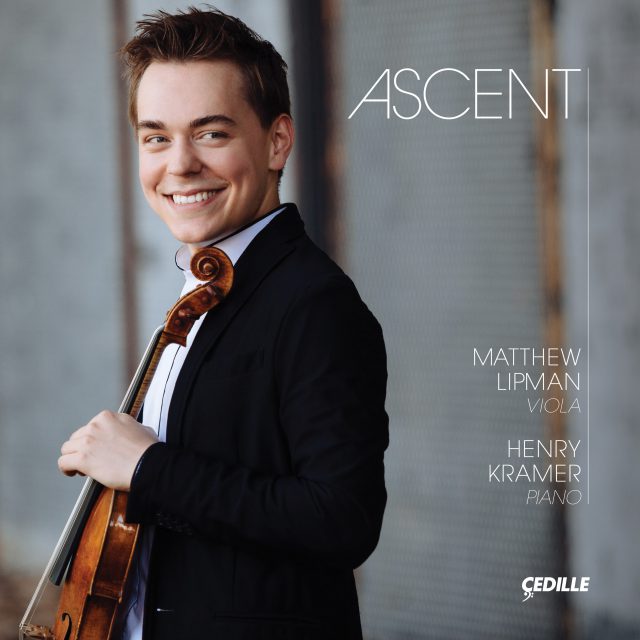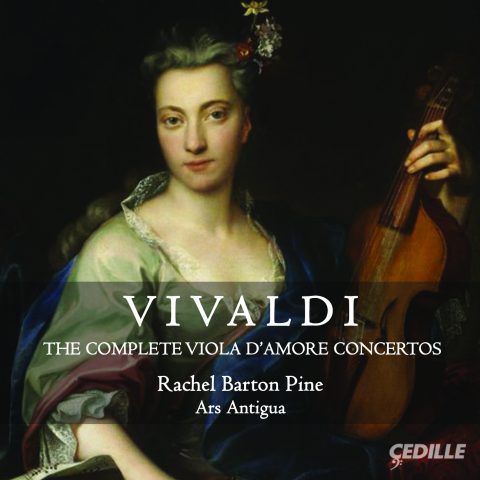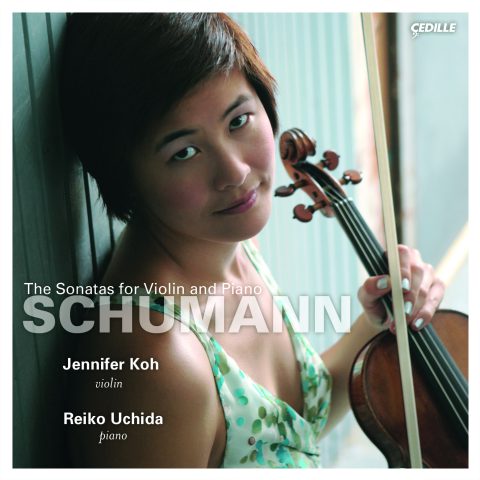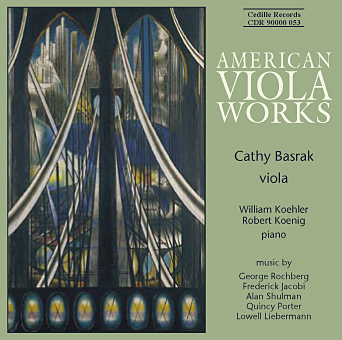Store

Dmitri Shostakovich’s long-lost Impromptu for Viola and Piano, Op. 33, recently unearthed in the Moscow State Archives, receives its world-premiere recording on Matthew Lipman’s Ascent, the acclaimed young American violist’s solo debut album, featuring, in the artist’s words, “music enraptured by flights of fantasy.”
Recipient of a 2015 Avery Fisher Career Grant, Lipman has created an album of uplifting and spiritually transcendent works for viola and piano, dedicated to his late mother.
Hailed by The New York Times for his “rich tone and elegant phrasing,” Lipman is heard in the world-premiere recording of Clarice Assad’s fantasy piece, Metamorfose, which the violist commissioned. It’s a poignant commentary on grief and acceptance. Robert Schumann’s Fairy Tale Pictures is dreamlike and fanciful. York Bowen’s richly expressive Phantasy draws on the Russian Romantic tradition. Garth Knox’s free-flying Fuga libre transfigures Bach-like fugal fragments through modern, coloristic performance techniques. The album’s finale is the first-ever recording on viola of Hollywood composer Franz Waxman’s popular violin showpiece, Carmen Fantasie.
England’s The Telegraph praised Lipman as “gifted with poise and a warmth of timbre” for his recording of Mozart’s Sinfonia Concertante with violinist Rachel Barton Pine, the Academy of St. Martin in the Fields, and Sir Neville Marriner (Avie), which topped the Billboard classical chart.
Lipman’s collaborator on Ascent is pianist Henry Kramer, winner of the Second Prize at the 2016 Queen Elisabeth competition and top prizes at the 2015 Honens International Piano Competition and 2011 Montreal International Music Competition. His first commercial recording, dedicated to Liszt oratorio transcriptions, was recently released on Naxos.

Listen to Jim Ginsburg’s interview
with Matthew Lipman on Cedille’s
Classical Chicago Podcast
Preview Excerpts
YORK BOWEN (1884–1961)
CLARICE ASSAD (b. 1978)
Metamorfose
ROBERT SCHUMANN (1810–1856)
Märchenbilder, Op. 113
GARTH KNOX (b. 1956)
DMITRI SHOSTAKOVICH (1906–1975)
FRANZ WAXMAN (1906–1967)
Artists
Program Notes
Download Album BookletPersonal Note
Notes by Matthew Lipman
This album was made as an homage to my mother, Robin Lipman (12/21/1949 – 7/17/2014). She was one of the most generous, selfless, and empathetic people I have known. She had the innate ability to make everyone around her feel comfortable and valued, and she could light up the room in any situation with her larger than life personality. She was my best friend.
The creative process behind the music started when I asked the wonderful Clarice Assad to compose a fantasy piece for viola and piano as a tribute to my mother. The resulting Metamorfose is a poignant commentary on the grief process (part I) and letting go (part II — Dance of the Butterflies). It seemed fitting, therefore, to pair this musical focal point with other music enraptured by flights of fantasy: the Schumann Fairy Tale Pictures and Bowen Phantasy as heart-on-sleeve fantasias with deft character changes, the Knox Fuga Libre as a piece that literally flies free, the Shostakovich Impromptu that was composed impetuously in one sitting, and the virtuosic Waxman Carmen Fantasie, originally a college project of mine, that embraces its larger than life personality. I wanted to title this personally meaningful album Ascent not only to describe the music it contains, but to allude generally to the upward movement that happens throughout life and after.
There are many complex moving parts to making an album, and I am so grateful for everyone who has been involved and supportive, especially Henry, Jim, Judy, Patrick, Julia, and Jeanne.
METAMORFOSE
Notes by Clarice Assad
When Matthew approached me to collaborate on a project, I immediately fell in love with him. There was something incredibly genuine about his personality, and I was mesmerized by his flawless virtuoso playing, besides being swept away by his musicality as a whole. He asked me if I could write a piece in memory of his mother; while I was beyond touched by the request, I also became really nervous at the thought that I might not do it justice, so I lived with this idea for a long time before writing down a single note. I wanted to learn more about him and their special relationship, and only time could afford me the opportunity to do this.
By the time I started writing Metamorfose, I had a good idea of the relationship between Matt and his mother: the sweet and bittersweet moments, the lingerings of pain still present in his voice when he mentioned how much he missed her, and the long journey of recovery into the person he is today.
In my mind, the metaphor became clear in the beautiful and unexpectedly gruesome metamorphosis of a butterfly. When compared to the grieving process, in all its stages, it made so much sense to me. The story of emotional, physical loss and pain; the transition from something so excruciatingly difficult into the freedom that perhaps only acceptance can provide to so much of the suffering that takes place in the world.
So this is an homage to Matt and his mom, a musical portrait of two different people, in two different worlds and instances, bound by the passage of time and love. Thank you, Matt, from the bottom of my heart: for trusting me, and for the gorgeous rendition of the piece that you carefully elaborated with Henry Kramer.
Program Notes
Notes by Patrick Castillo
YORK BOWEN: PHANTASY FOR VIOLA AND PIANO, OP. 54
Known as “the English Rachmaninov,” York Bowen (1884–1961) ranked among the most celebrated English pianists and composers of his generation. As with Rachmaninov, Bowen’s compositional style was an unapologetic vestige of the Romantic era (and, indeed, indebted particularly to the Russian tradition); also like his Russian contemporary, Bowen’s posthumous legacy suffered from the datedness of his language against the backdrop of 20th-century modernism. Yet no less than Camille Saint-Saëns regarded Bowen as “the most remarkable of the young British composers,” and many of his works (notably his Third Symphony and Fourth Piano Concerto) received frequent performances during his lifetime. But while Rachmaninov’s reputation has been rehabilitated, Bowen, half a century hence, has yet to be recognized as among the early 20th century’s master composers.
Bowen, like Rachmaninov, was equally accomplished as a pianist and composer. He gave the British premiere of Mozart’s Concerto in F Major for Three Pianos, K. 242, and the world premiere of William Walton’s Sinfonia concertante, and made the first recording of Beethoven’s Fourth Piano Concerto. (He was, moreover, proficient in numerous orchestral instruments, particularly the viola and horn — a facility evident in the idiomatic writing throughout his instrumental scores.) Bowen performed his own compositions with leading virtuosi of the day, including violinists Fritz Kreisler and Joseph Szigeti, and formed a duo with Lionel Tertis, widely hailed as the “father of modern viola.” Tertis inspired Bowen’s two Viola Sonatas, in C minor, Op. 18, and F major, Op. 22, both composed in 1905,
and Viola Concerto in C minor, Op. 25, composed in 1908.
Alongside these, Bowen’s contributions to the viola literature include the
Phantasy, Op. 54, composed in 1918 for a competition established by the amateur violinist and patron Walter Willson Cobbett. The Cobbett competition, begun in 1905, invited “phantasies” — single-movement works
comprising three or four sections of distinct rhythms and characters — for different instrumentations. Its winners over the years have included Frank Bridge (for his Phantasie Piano Trio of 1907), Herbert Howells, and John Ireland.
Bowen’s Phantasy obliges, condensing a three-movement sonata-like arc into one movement; at fifteen minutes, it is about half as long as each of his
Viola Sonatas, but lacks nothing of those larger works’ textural variety
and expressive dimension.
Following a ruminative introduction in which the opening section’s primary thematic material is introduced — uttered first by viola alone, piano, dolce e poco espressivo, then paced by soft, mysterious chords in the piano — the Phantasy quickly takes flight. The proceeding music bubbles with effervescent melody, dancing gleefully from the viola’s singing high range to its sonorous low register. As it unfolds, the Phantasy’s first section juxtaposes the slow music of the introductory measures with its Più allegro transformation.
This music yields to the romantic Poco adagio middle section, in warm D-flat major. The viola, pianississimo, con sordino, croons a debonair melody,
descendent from the work’s opening theme, and underpinned by a gently
pulsating accompaniment in the piano. The Phantasy concludes with a
well-caffeinated Allegro vivo section.
ROBERT SCHUMANN: MÄRCHENBILDER, OP. 113
When he was 18 years old, Robert Schumann (1810–1856) traveled to Leipzig to study with pianist Friedrich Wieck. He lodged in his teacher’s home and developed a close friendship with Wieck’s nine-year-old daughter, Clara, herself a gifted pianist. The friendship blossomed years later into Western classical music’s most storied love affair. After a protracted legal battle with Clara’s forbidding father, the two were married in 1840.
Within a few years of their marriage, Robert Schumann’s physical and mental health began steadily to deteriorate. He battled bouts of depression, insomnia, and, eventually, psychosis. In February 1854, Schumann’s mental state reached its nadir: after weeks of unbearable psychotic episodes, he threw himself into the Rhine, but was saved by passing fishermen. Following his suicide attempt, fearing he would inadvertently harm his wife and children, Schumann entered a mental asylum near Bonn. He never saw his children again, and Clara was not permitted to see her husband until the day before he died in 1856.
Just as the hallmarks of Schumann’s life thus encapsulate the popular notion of Romanticism — the embattled artist as hero of his own mythos — so does the essence of his compositional output. And while correlating art and biography generally makes for tenuous scholarship, in the case of Schumann, one feels that the tenderest melodies must indeed be heard as love songs to Clara, his muse; that contrasting humors are a dialogue between his alter egos, the extroverted Florestan and the introspective Eusebius; and that the ecstatic highs, piercing aches, and inconsolable despair that mark his greatest creative triumphs represent experiences felt in the depths of his soul.
Schumann originally envisioned a literary career, and maintained a second profession as a critic throughout his compositional life. His Märchenbilder (Fairy Tale Pictures), Op. 113, composed in 1851, reflect his literary bent. A set of four miniatures scored for viola and piano (with an arrangement for violin and piano as well), the Märchenbilder likewise capture an essential part of the Romantic zeitgeist: its penchant for the dreamlike and fanciful. Its individual movements bear no specific titles or programs. Although Schumann toyed with other titles for the set, such as Märchengeschichten and Märchenlieder (“Fairy Tale Stories” or “Fairy Tale Songs”), “Fairy Tale Pictures” ultimately won out, suggesting that Schumann considered these pieces evocative, rather than narrative, in character.
The first of the Märchenbilder, set ruminatively in D minor, is brooding and evocative, its keening melody finding perfect voice in the viola’s dusky timbre. The character changes dramatically in the second movement, marked Lebhaft (lively). A galloping dotted rhythm lends the movement its vitality; double-stopped chords in the viola further infuse the music with a sonic fieriness.
The third movement begins with restless triplet figurations in the viola, accompanied by decisive chords in the piano. An elegant middle passage, although less agitated, sacrifices nothing of the previous music’s ardor.
Schumann assigns the finale the expressive tempo marking Langsam, mit melancholischem Ausdruck (Slowly, with a melancholy expression). This deeply felt conclusion to the Märchenbilder features melodic writing of heart-stopping beauty, one of Schumann’s greatest assets. Here again (the composer’s alternate version for violin notwithstanding) the viola’s shadowy hue seems the ideal medium for the music’s quietly penetrating beauty.
GARTH KNOX: FUGA LIBRE
As violist of the Paris-based Ensemble InterContemporain from 1983 to 1990, and subsequently of the Arditti Quartet from 1990 to 1997, Garth Knox (b. 1956) has built a reputation as one of his instrument’s leading proponents in the realm of contemporary music. Knox has collaborated with many of the 20th and early-21st centuries’ leading composers, including Pierre Boulez, György Kurtág, György Ligeti, Karlheinz Stockhausen, and others.
Knox is likewise an accomplished composer in his own right. He is the author of Viola Spaces, a series of etudes that explore extended instrumental techniques; and his Fuga libre, composed in 2008 for the Tokyo International Viola Competition, reflects his dual interests in early and contemporary musical expression. It begins with chromatic, pseudo- Bachian fragments (indeed, the very endeavour of creating fugal music for a solo string instrument inevitably evokes Bach’s Sonatas and Partitas for Solo Violin and Suites for Solo Cello), but promptly transfigures this material through modern techniques: sul ponticello, harmonic glissandi, and other coloristic effects. Amplifying this duality between old and new, Knox included his Fuga libre on his album Saltarello (ECM, 2012) alongside arrangements of music for viola d’amore by Purcell, Vivaldi, John Dowland, and Hildegard von Bingen.
DMITRI SHOSTAKOVICH: IMPROMPTU, OP. 33
The Impromptu for viola and piano, Op. 33, by Dmitri Shostakovich (1906–1975) dates from 1931. Previously lost, the work was discovered in 2017 in the Moscow State Archives among the effects of Vadim Borisovsky, violist of the Beethoven Quartet, with whom Shostakovich enjoyed a fruitful partnership throughout his career. The manuscript, dated May 2, 1931, bears a dedication to “Alexander Mikhailovich” — presumably Alexander Mikhailovich Ryvkin, violist of the Glazunov Quartet. Experts surmise that Shostakovich penned the Impromptu in one sitting.
It joins Shostakovich’s final work, the considerably more substantial Viola Sonata, Op. 147 (1975), as the composer’s only works for viola and piano.
Although petite, spanning just two minutes, the Impromptu nevertheless bears Shostakovich’s unmistakable voice, from the plaintive opening melody, which takes a sardonic turn in just the fourth measure, to the devilish spiccato strokes of the brief concluding Allegro section.
FRANZ WAXMAN: CARMEN FANTASIE
In 1929, the German film composer Friedrich Holländer happened upon the 23-year-old Franz Waxman (1906–1967) playing piano in a Berlin nightclub to support himself through his musical studies. The following year, Holländer invited Waxman to arrange and conduct his score to The Blue Angel, the film that launched Marlene Dietrich to international celebrity.
Waxman found his calling in film music. In 1934, he immigrated to the United States and settled in Los Angeles, where he rose to prominence as one of the quintessential composers of Hollywood’s Golden Age. His first original film score, for The Bride of Frankenstein (1935), established a new standard for the horror movie genre, and his oeuvre of 144 film scores, including Captains Courageous (1937), The Philadelphia Story, Rebecca (1940), Dr. Jekyll and Mr. Hyde (1941), The Nun’s Story (1959), and Taras Bulba (1962), defined the sound of a cinematic era. He received twelve Academy Award nominations and won twice, for Sunset Boulevard in 1950 and A Place in the Sun in 1951.
Waxman was also active as a composer of concert music. His oeuvre includes Joshua, an oratorio composed in 1959, and the song cycle The Song of Terezin, his final work, composed in 1965. At the time of his death in 1967, Waxman had begun sketching an opera on Dr. Jekyll and Mr. Hyde.
His work of most enduring popularity, the Carmen Fantasie, unites these two facets of Waxman’s musical profile. A virtuoso showpiece for violin and orchestra based on themes from Bizet’s Carmen, the work was originally composed for the 1947 film Humoreske (which garnered one of Waxman’s dozen Oscar nominations), starring John Garfield and Joan Crawford, respectively, as a struggling young violinist and his older, wealthy patroness, who become romantically entangled. Jascha Heifetz was meant to play on the soundtrack, but when Warner Brothers balked at his contractual requirements, the 26-year-old Isaac Stern was engaged instead. (In the film, Stern’s hands can be seen in close-up shots.)
Waxman later reworked the Carmen Fantasie into a virtuoso showpiece for Heifetz, whose recording stands as one of the most beloved documents of the great virtuoso’s art. It also remains Waxman’s most beloved concert work, rife with irresistible melodies, animated by stunning instrumental pyrotechnics, and frequently appears in arrangements for various instruments, as on the present recording, adapted for viola and piano — a particularly appropriate adaptation given that the main role in the opera is sung by an “alto” voice.
© 2018 Patrick Castillo
Patrick Castillo is the founding composer and Director of Third Sound and Executive Director of the contemporary music ensemble Hotel Elefant.
Album Details
Producer and Engineer: Judith Sherman
Engineering and Editing Assistant: Jeanne Velonis
Engineer: Charles Mueller (Shostakovich)
Mastering: Bill Maylone
Cover Photo: Jiyang Chen
Graphic Design: Bark Design
Recorded: American Academy of Arts and Letters, New York, NY, October 1–3, 2017, and April 25–26, 2018 (Assad); July 7, 2018 at Oktaven Audio, Mount Vernon, NY (Shostakovich)
©2019 Cedille Records/Cedille Chicago
CDR 90000 184


